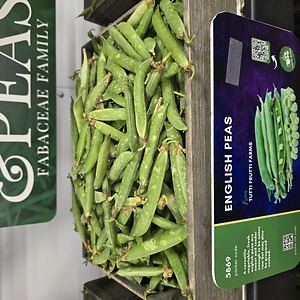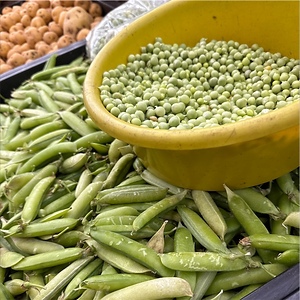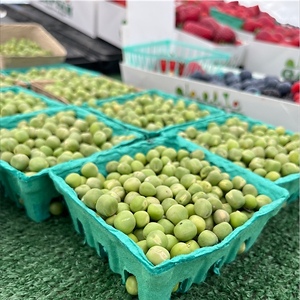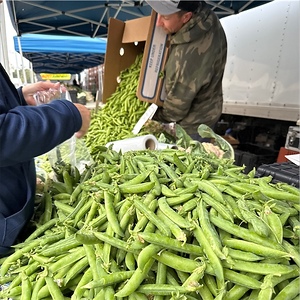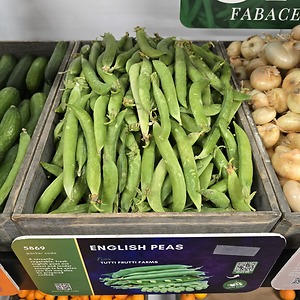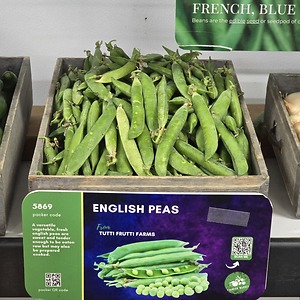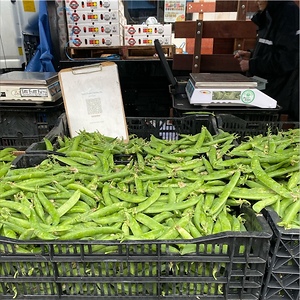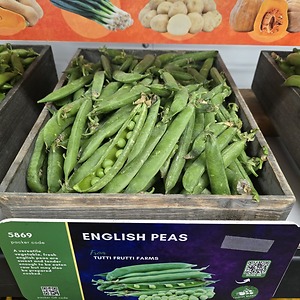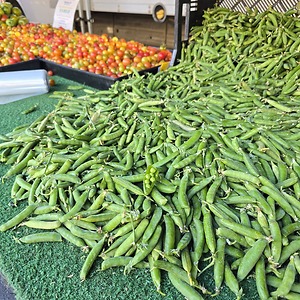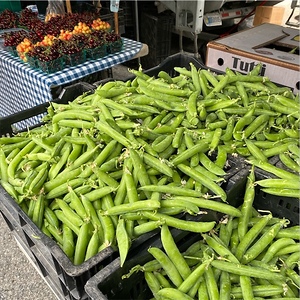


English Peas
Estimated Inventory, 30 lbs : 9.83
This item was last sold on : 07/29/25
Description/Taste
English peas vary in size and shape, depending on the specific variety, and average 7 to 10 centimeters in length. Each plant produces fleshy, fibrous green pods that are plump, curved, and have tapered, pointed ends. The pods are inedible and must be removed before eating, and the pod is shelled by snapping off the end and pulling the string that extends along the center seam. Once opened, the pods reveal 5 to 10 seeds attached to short stalks. The seeds are round to oval and typically have a green coloring. Some varieties may also have purple or yellow hues. English pea seeds are edible raw and have a tender, crisp, and firm consistency. The seeds can be felt through mature pods, and when eaten raw, the seeds have a fresh, sweet, green, and grassy flavor. It is important to note that the seeds begin transforming their sugar content into starch soon after harvest. The seeds should be eaten within a few days of purchase to ensure they have a sweeter, less starchy nature.
Seasons/Availability
English peas are grown in both hemispheres and are available year-round in some regions, with a peak season in the spring through early summer.
Current Facts
English peas, botanically classified as Pisum sativum, are a broad category of culinary varieties belonging to the Fabaceae family. Peas grow on leafy bushes or climbing plants that attach to walls, trellises, and other support structures and are grown in gardens as an herbaceous, fresh crop. English peas are also called Garden, Shelling, and Green peas. Several varieties are generally categorized under the English pea name, and these cultivars are famous for their versatility and ability to be eaten raw or cooked, discarding the pod. In present-day markets, most commercial peas sold frozen, dried, canned, or fresh are a type of Garden or English pea. Fresh English peas are favored for their sweet, green taste and are a seasonal springtime delicacy incorporated into a wide array of culinary preparations by both professional chefs and home cooks worldwide.
Nutritional Value
Peas are a source of vitamins A, B, C, and K to maintain healthy organs, strengthen the immune system, produce energy, and aid the body in faster wound healing. Peas also provide other antioxidants to reduce inflammation, as well as minerals such as potassium, phosphorus, calcium, and iron. Potassium balances fluid levels within the body, while calcium and phosphorus support bones and teeth. Iron develops the protein hemoglobin for oxygen transport through the bloodstream, and other nutrients include magnesium, zinc, folate, and manganese. When English peas are in season, shelling the seeds from the pods was historically a social affair to speed up the labor-intensive process. During the shelling process, local superstitions were created in England to pass the time. The most famous belief is that it is considered good luck and a blessing of good health if nine peas were found in the first pod shelled.
Applications
English peas have a fresh, sweet, grassy flavor for raw and cooked preparations. The seeds must be separated from the pods before consumption as the pods are too fibrous to consume. Once shucked, English peas can be eaten fresh as a sweet snack or tossed into grain bowls and salads. They can also be blended into thick dips like hummus or pesto. In addition to fresh preparations, English peas are popularly blanched and served with herbs and melted butter. In England, mushy peas are a famous fish and chips side dish that has been paired with meals since at least the 19th century. The use of mashed peas also dates back to medieval times throughout Europe as a protein source. Peas are added to pot pies, roasts, and casseroles or are simmered into soups, curries, and stews. They have also been incorporated into cuisines around the world, including fried rice, stir-fried noodles, pasta dishes, or as a side to roasted meat. For a more sustainable lifestyle, the shelled pods cannot be eaten, but they can be used to infuse flavor into vegetable stock. The seeds can also be pickled, dried, or canned for extended use. English peas pair well with other springtime ingredients like ramps, herbs, morel mushrooms, spring onions, fiddleheads, and asparagus. They also are used year-round with mint, aromatics like garlic, ginger, and shallots, carrots, potatoes, spinach, and other root vegetables. Whole, unshelled English peas will keep for 4 to 5 days when loosely stored in a container in the refrigerator’s crisper drawer. If the seeds are shelled, use them within two days of shelling. Peas will break down their natural sugars into starches over time. The quicker they are used after the purchase, the better flavor the seeds will have.
Ethnic/Cultural Info
Peas were once used to wake families in London during the 19th and 20th centuries. Before developing reliable and affordable alarm clocks, London residents could hire people to rap on their doors or windows each morning. These hired hands were known as knocker-uppers and were often used by families working as servants in households or factories. Knocker-uppers were known for being creative in their methods as it was important they only woke the family they were hired for and not their neighbors. Some knocker-uppers would arrive at households as early as 4:00 AM and tap on the window with flexible sticks. While sticks worked smoothly for rooms on the first and second floors, wealthier homes with multiple stories were challenging to reach. Knocker-uppers began using dried peas and would shoot them using a blow-tube to reach the upper floors. The dried peas would make enough noise on the windows to wake the families, but they would not damage the windows. Mary Smith was the most famous knocker-upper who used a pea shooter. She would wake families in East London with a pea shooter and earn sixpence a week for this position. Mary Smith had a reputation for being reliable and continued her profession into her 60s. When more affordable alarm clocks were introduced in the 1920s and 30s, Mary Smith was considered one of the last Knocker-uppers in London and was featured in photos from local newspapers that are still shared as a piece of history in the modern day.
Geography/History
Pisum sativum is considered one of the oldest cultivated species, and wild descendants have been naturally growing since ancient times. The origins of Pisum sativum are debated, with the most common theory tracing wild plants to regions of the Mediterranean and the Middle East. Carbonized pea remains have been found in archeological sites in Turkey and Iraq, which are thought to date back to around 7,000 or 6,000 BCE. Early types of peas were also present in Ancient Egypt, Greece, and Rome. Historically, peas were consumed fresh and dried. Over time, pea plants were taken from the wild and selectively bred for improved culinary characteristics. This led to the creation of many varieties under the Pisum sativum species, and these cultivars expanded to regions throughout Europe, Asia, and Africa. Peas were an important food source in Europe during the Middle Ages and were grown in fields and monastic gardens. In the 15th century, new varieties of peas were bred for fresh eating, leading families to plant the climbing plants in home gardens. Peas shifted from being a poor man’s culinary ingredient to a fashionable food of nobility, and they continued to evolve with advanced breeding practices, becoming known as garden peas. The term English pea arose in the 17th century when British plant breeders developed several new varieties of garden peas and released them to the public. The association with the cultivar’s creation in England stuck, and the term became interchangeably used with garden or shelling peas. Peas were later introduced to the New World by explorers and colonists, expanding the species to gardens globally. Today, English peas are grown worldwide and are sold fresh in local markets. They are also dried, canned, or frozen for extended use and sold through supermarkets and larger retailers.
Featured Restaurants
Restaurants currently purchasing this product as an ingredient for their menu.
| Valley View Casino & Hotel (Black&Blue) | Valley Center CA | 760-291-5500 |
| Miho | San Diego CA | 619-365-5655 |
| Secret Sister | San Diego CA | 619-281-0718 |
| Great Maple Hillcrest | San Diego CA | 619-255-2282 |
| The Lion Share 2025 | San Diego CA | 619-564-6924 |
| Mabel's Gone Fishing | San Diego CA | 619-228-9851 |
| Lilo | Carlsbad CA | 619-385-0914 |
| Brigantine Escondido | Escondido CA | 760-743-4718 |
| Panama 66 | San Diego CA | 619-206-6352 |
| Gravity Heights Restaurant and Brewery | San Diego CA | 858-551-5105 |
| Convention Center Shell | San Diego CA | 619-954-3063 |
| US Grant Hotel Grill | San Diego CA | 619-232-3121 |
| Georges at the Cove | San Diego CA | 858-454-4244 |
| The Beau Hotel | San Diego CA | 619-310-5160 |
| Fairmont Grand Del Mar | San Diego CA | 858-314-1975 |
| Tahona (Kitchen) | San Diego CA | 619-573-0289 |
| Institutes of Health LLC | San Diego CA | 800-270-5016 |
| Animae | San Diego CA | 619-925-7908 |
| Fort Oak | San Diego CA | 619-795-6901 |
| Hotel La Jolla - Sea & Sky | La Jolla CA | 858-459-0261 |
| Sheraton Carlsbad (20/20) | Carlsbad CA | 760-827-2400 |
| Paradise Point Resort Tidal | San Diego CA | 858-490-6363 |
| Estancia Adobe | San Diego CA | 858-550-1000 |
| Kinme Omakase | San Diego CA | 619-231-0700 |
| Kona Kai Resort and Marina | San Diego CA | 619-221-8000 |
| Lauberge Del Mar | Del Mar CA | 858-259-1515 |
| Rancho Santa Fe Golf Club | Rancho Santa Fe CA | 858-756-1582 |
| Le Coq | La Jolla CA | 858-427-1500 |
| The Lion Share | San Diego CA | 619-564-6924 |
| Brigantine La Mesa | La Mesa CA | 619-465-1935 |
| South O Brewing Catering | Oceanside CA | 925-381-5392 |
| Ctzn | Solana Beach CA | 858-925-7141 |
| InterContinental Vistal Kitchen | San Diego CA | 619-501-9400 |
| Trust Restaurant | San Diego CA | 609-780-7572 |
| Boujiemana | San Diego CA | 415-710-0510 |
| Gravity Heights Mission Valley | San Diego CA | 619-384-5993 |
| C 2 C | San Diego CA | 619-972-9345 |
| Javier Plascencia (Animalon) | Bonita CA | 619-295-3172 |
| The Santaluz Club Inc - Main Dining | San Diego CA | 858-759-3150 |
| Le Papagayo (Encinitas) | Encinitas CA | 760-944-8252 |
| Park Hyatt Aviara | Carlsbad CA | 760-448-1234 |
| Pacific Yacht Agents | Los Angeles CA | 808-214-0970 |
| Urban Kitchen Catering | San Diego CA | 619-276-8803 |
| Lodge at Torrey Pines Grill | San Diego CA | 858-453-4420 |
| LANA | Solana Beach CA | 602-758-2596 |
| Lodge at Torrey Pines Main | San Diego CA | 858-453-4420 |
| Juniper & Ivy | San Diego CA | 858-481-3666 |
| Manchester Grand Hyatt San Diego | San Diego CA | 619-232-1234 |
| Herb & Sea | Encinitas CA | 858-587-6601 |
Recipe Ideas
Recipes that include English Peas. One



